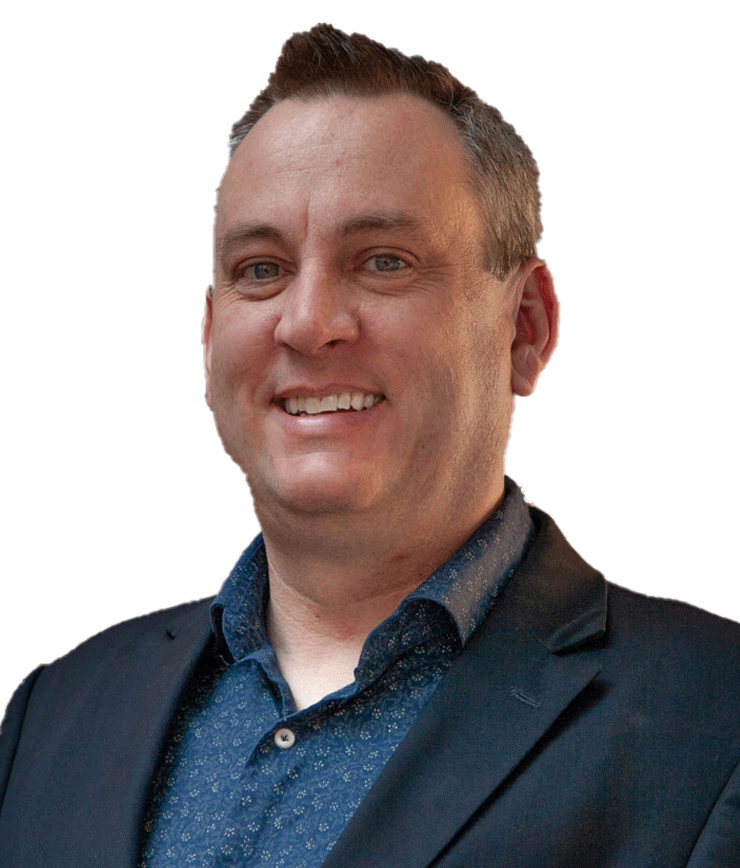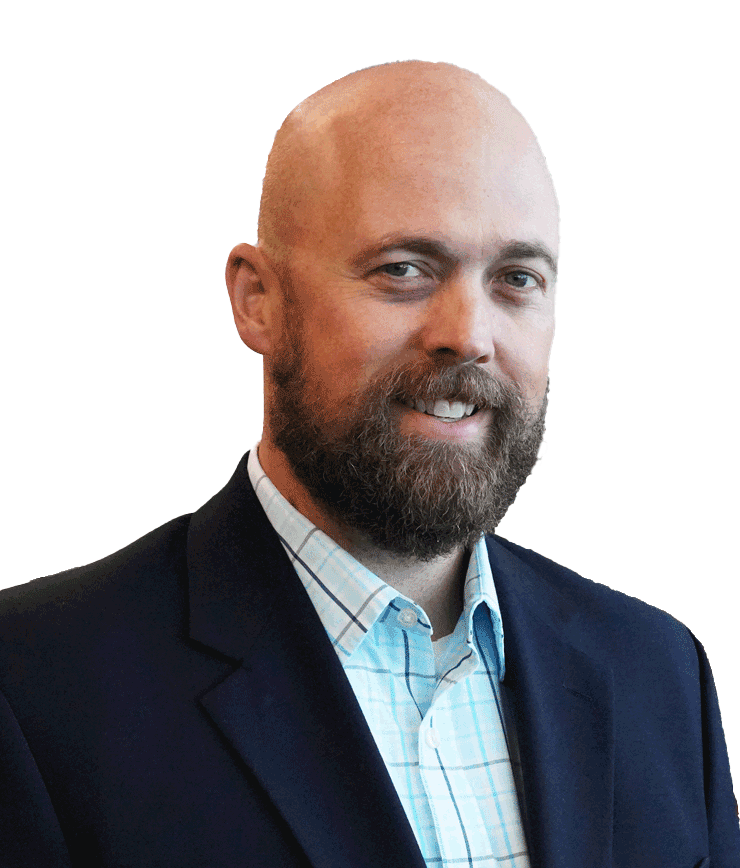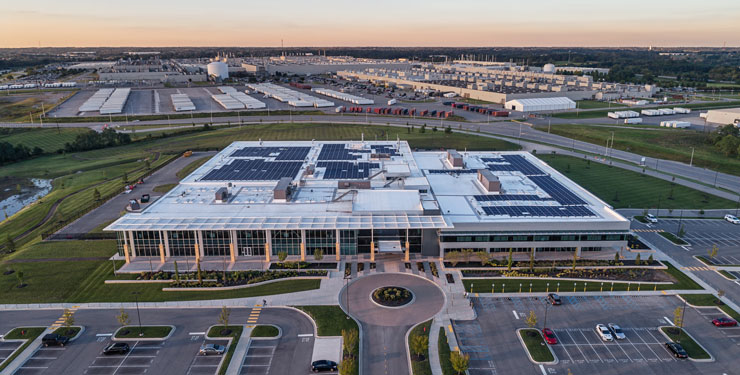
Actionable ESGs: Achieving Ambitious Corporate Goals in Sustainability Part 2

Want to listen on another platform? Choose your platform here.
Episode Transcript
(Music Intro)
Brian Trainer, Host: Welcome to Trends + Tensions presented by BHDP, where we discuss trends in architectural and interior design and the competing priorities or tensions that arise from integrating new ideas into existing organizations, enterprises, and institutions. In this episode, “Actionable ESGs: Achieving Ambitious Corporate Goals in Sustainability: Part Two,” BHDP’s Daniel Lessing brings local leaders in sustainability together to discuss the growing importance of ESGs for organizations. ESG stands for environmental, social, and governance, and ESG practices set businesses apart when it comes to establishing their credibility and impact on the community. Organizations like the Cincinnati 2030 District, which is facilitated by Green Umbrella, the region's leading sustainability alliance, use their resources to help businesses identify and achieve their goals of lowering energy use, water consumption, and transportation by 50% by 2030. 2030 District is a global network of districts committed to making meaningful changes within cities that address climate change. Elizabeth Rojas, Director of Cincinnati 2030 District, as well as P&G’s Melissa Doughty, North American CSA Manager for Global Facilities Engineering, and Steve Winbigler, Global Technical Director of Facility Technical Systems at corporate offices and research sites, join us to offer practical tips for organizations building or implementing their ESGs. I am your host, Brian Trainer, Senior Strategist for BHDP. Let's get started.
Brian: Elizabeth, could you tell me a little bit more? What is Cincinnati 2030 District, and what do they do?
Elizabeth Rojas: Okay, Brian. Well, this is a really an amazing initiative. First of all, we are rooted in a national organization that's been around for nearly ten years. Essentially what we do is we work in different districts—we have 23—we all work towards the same goals, the 50% reductions, and we measure that in the same fashion, actually, for energy and for water. We work with building owners and managers, and we connect with them about what their building is doing, how it's performing, and we benchmark that building. Essentially, benchmarking is looking at either a historical data set or a national data set, and for energy, we do that with a national data set. Then for water, we look at how much water they're using in their building, and we look at how they can reduce that water. For transportation, each district really comes up with their own metrics, and so here in Cincinnati, we are working against a 2015 baseline. And for energy, it's a 2003 baseline. In our district, we have about 300 buildings. Some of those are already net zero, and we have others that are well on their way to being at 50% or maybe 25 or 30%. And then we have some older ones that are going to be super poor performing because they were built in the 1800s, for instance.
Daniel Lessing: Yeah, so my daytime job is Client Leader at BHDP. My part-time job is the leader of the Energy Impact Team, which is part of the 2030 District. What I've really enjoyed is—to Elizabeth's point—is we have connected Kroger, Fifth Third, and Procter & Gamble with a small restaurant, like Sleepy Bee Café, and we're leveraging these community resources to level the sea up, right, and all the boats are going to rise with the sea. Really, what we've seen over the past few years is we're building momentum, getting more people on board, and really sharing the word and trying to inform as many people as we possibly can. It’s not that hard. All you got to do is take that first step, and then there's a community around you—the Procter & Gamble’s, the Fifth Third’s, professional partners like BHDP, and a lot of our other professional partners here in the city that are here to help you as you start your journey.
Brian: It sounds like a community of shared resources, shared information, shared experience, “here's what we've learned that can work.” If you're a smaller independent business, you are the facilities committee, wearing a lot of hats, and that's a lot to wrap your arms around, I would imagine. So that brings me to—we want to talk to Melissa and Steve. Both of you are really “boots on the ground” for the environmental issues, correct?
Steve Winbigler: Exactly, yeah. There are the corporate goals that are set, and then there are the people who have to convert the high-level strategies in the action plan, and that's where I come into play.
Brian: P&G does have an ESG policy, but we want to talk about how you're involved in the environmental pieces, but first of all, how did the partnership between P&G and Cincinnati 2030 District manifest?
Steve: As part of our work against sustainability and our emissions and energy use goals, we've been against that since about ’09, ’10—that’s when we basically started a real concerted effort to really start driving improvement in those areas. And then, with that work underway, then Elizabeth reached out, when the District came into formation, to our manager, Jack mcananny, and then that kind of got the wheels moving for us to start to collaborate more and become part of the District. Elizabeth, do you have more you want to share there?
Elizabeth: So, part of the story is that the 2030 District started as a group of a couple of organizations and leaders in this community that came together and said, “Hey, we want to have a way of catalyzing this change within our community and really lifting up this region.” So, we sat around, talked with people from the city, people from the design field, and Fortune 500 companies, small organizations, and when this came about—and this was in 2018—we essentially said, “We need ten different organizations to join the District,” and P&G was one of the founding members of the District. Once we started getting the momentum going, we really started growing from there. And so now, we have this really striking, large square footage—nearly 30 million SF—dedicated to the District now. So, I think we were ripe for this kind of change. The other thing about the incentive that I just want to kind of comment on is that companies are now finding that they don't want to be left behind in this. This District has momentum behind it now, and we don't want to have people left behind. People really are reaching out so that they can get engaged.
Brian: Yeah, Melissa, didn't you say that you had recently reevaluated your 2030 goals, as well as your 2050 goals? Did I misunderstand?
Melissa Doughty: No, you didn't misunderstand at all. So, if you look back at the sequence of events, we set our first greenhouse gas goal in 2007, and then by 2018, we made such great progress towards our goals with greenhouse gas emissions and water use and manufacturing, and then our manufacturing waste to landfill efforts that we announced our ambition 2030 plan. And that plan was to cut greenhouse gas emissions in our plants in half and to increase our circular water sources. Essentially, it captured more than that, but those were the two big ones. So then, in 2020, we added goals for our operations side, and in 2021, we announced our net zero 2040 goals. So that's to achieve net zero greenhouse gas emissions across our operations and supply chain. So, I came into the company a little over a year ago, right when we were starting the effort of aligning our ambition and 2030 goals to enable us to actually meet our net zero 2040 goals.
Brian: It sounds like a daunting task, but after a year and three months, you seem like it's not killing you. [laughs]
Melissa: [laughs] Well, I played a very small role in it, but it was very interesting for me to come into a company that had such a sustainability focus. I sit next to the sustainability team in my office, so I overhear all of these wonderful conversations, and I'm thinking, “What a gift to be given to be able to sit in a company that influences so much around the world.” I mean, it's very exciting, but it's a major undertaking to look at each of the plants and the research facilities and the offices in our portfolio, look at the baseline, look at the area, look at the technologies that we've developed and the technologies we think we can pursue, match them to the facilities in question, look at what's available on the supply chain to that particular plant, and say, “What realistically can we do for each facility? What can't we do?” And it takes a whole large team of people to assess this, get all of the data together, and to come to a conclusion about what realistically can be done. I mean, we're beholden to our shareholders and our community, and there are so many people who are interested in what we do—it’s a lot of factors at play that we have to balance, but we have a good plan. We're continuously re-baselining and reevaluating and developing technologies.
Steve: I would just throw in along with that, too—Elizabeth had mentioned, “Hey, there are large institutions like P&G,” but there are also smaller companies. And a lot of times when you use the word ‘sustainability,’ sometimes people think of this massive effort and “I've got to have solar fields” and “I've got to have all these massive technologies” and “engineers come in before I can even start.” And if you want to think about it, go through your facility and look at your business operations and how they run, and really ask yourself, “When does that have to absolutely run, and for how long does it have to run?” and just start doing some basic mapping like that, and you might find a whole lot of stuff that doesn't seem like a lot, but, “Oh that's still on. It could have been shut off two hours ago. This thing started up two hours later because, in this part of the operation, it's preceded by three other things,” right? And just doing some basic mapping on just a notebook, a piece of paper, with a pencil, and you just start writing out and mapping these things and doing a little bit of energy mapping, a little bit of water mapping—you might come in and cut out 10 to 15% of your facilities operational costs just by starting to map out the sequence of when things absolutely have to run and for how long they need to run. Just putting in a very simple concept.
Elizabeth: You know, that's a great point, Steve, because in the District, when we work with small organizations, and Daniel is actually one of the leaders of the Energy Impact Team, but we do offer these services now to building members that don't have a way to get started. So, if they start with our District and we work together with them, we can set them up with a free building walk-through program, and that really connects them to the professional partners that help deliver the services, and it gives them a place to start from. So, the goals of the district are really to support the community in general. So we utilize and leverage some of the folks that are engaged with the District, sitting around this table, but also, some of the really small organizations that need the support, too.
Daniel: The walkthrough program is all about taking the community, taking the professional partners, taking the large business owners that are part of that community, and really leverage those resources to help those new members. It's amazing how much difference we can make and how much reduction we can make if we just get folks measuring their usage, right? Step one is to measure—understand what your baseline is. And we spent a lot of effort over the past few years properly explaining, “What is energy star? What is portfolio manager? How do I track my utilities? Where do I get my utility bill?” Some of the companies that have signed on to the 2030 District, right—it’s on autopay. They don't think about it. Or, like some of the other facilities, they have several different meters. So, we got a couple of gas meters, a couple electric meters—how do I understand what my baseline is? And then, from there, we offer this initial walkthrough. So, we grab professional partners—I’ve done a few myself. I try to make sure that all the brewery tours, I do, for obvious reasons.
Brian: [laughs]
Elizabeth: That’s right. Free breweries, to be exact.
Daniel: So, I was just in a local brewery last week, doing a walkthrough, and their entire environmental sustainability is one person, and this is a giant plant. So, just doing a walkthrough with those people and helping them understand what their usage is. They don't have an entire sustainability team, they don't have LEED experts, but they know what's right, and they have a passion, and if we can just help them get the steps moving in the right direction, that's when that momentum gets behind them, and they can start showing that real change to their boards and get some momentum to start having real reduction.
Steve: Just kind of following up with Daniel, I mean, kind of with the sustainability, yeah, it's a mapping and measurement process for your emissions and doing that. You can look at renewable technologies like solar and wind turbines and things of that nature, but also, when you're going through your facility, and you're making sure that all the—believe this is true or not—but making sure that your windows are all properly caulked, your doors are sealed up, the dock door is shut promptly after the truck leaves—that’s sustainability, too, because anytime a building has to exert extra energy to take care of all that extra leakage, that's a bigger carbon footprint. And I've been in a lot of buildings where we went through, and we did some simple resealing and reworking on that thermal envelope and just some fundamental stuff with the mechanical equipment, and that was a 10 or 15% reduction right out of the gate in energy and associated carbon footprint. It's true. It's just that little eye for detail and that daily work and focus on your building that can make a big difference.
Brian: It's interesting because I'm on the board for a non-profit theater company, and we were looking at upgrading our theater lights to LED and changing out our air handling because we knew it would reduce operating costs, but nobody can tell me where the electric bill is. I need to get my hands on that, and that sounds like step one. So, get you the bill first—you have to start with a baseline. So, if somebody showed up from a non-profit and said, “Hey, here's the electric bill from our facility,” or whatever it is, can you help somebody like that?
Elizabeth: Absolutely, yeah. The way that we work is, essentially, talking with the building owners and team—whomever is involved—and we enter the data. And some organizations actually need our support in physically entering the data, but it's a fairly simple process of going on to a free platform, you enter the monthly utility bills for energy and water, and then you share that data with our district. We have a non-disclosure agreement, so we don't share that data with anybody outside of the organization unless somebody wants to tell their story, and then we're very happy to help them get that word out. But once that data is into us, then we basically baseline it against either historic data in some cases but mostly that 2003 baseline, and we can see where you stack up as a building. Then you get your own report, and we connect you with the partners that help you make the decisions. So for a small organization like yours, you would definitely receive a free building walkthrough program, and then you could get the support that you need to go through the building, and Daniel will bring the beer, [laughs] and we can have everybody participate. They actually work off a common checklist and then give that report to the building owner, which then becomes their framework for what they're going to do for the building.
Daniel: Yeah, the initial building that took advantage of the walkthrough program was the Contemporary Arts Center. An art museum and all of the very tight tolerances for humidity and temperature are large energy users, so taking advantage of every opportunity they can to find out how they can suck energy usage out of their building because they're a non-profit, right? If they can reduce their utility bill, they can push that into something else.
Elizabeth: And on top of that, our district works—we have teams that work together that are always looking for grants and ways to get money back into the hands of these organizations, and with the infrastructure bill and all the money that's coming from the federal government, there are going to be new avenues for those organizations to get funding. Not to mention that you can then take advantage of some of the tax credits as a non-profit now, which is a brand new way of looking at things. One of the things that I didn't mention yet was that the Cincinnati 2030 District pioneered this notion that we could have a healthy building district. And essentially working with the well-building standard and trying to support our building members in understanding what's available and what is out there, and then finding a way to kind of bring that together so that they can keep track of what they're doing towards their goals, we can really match that to a building's culture now. So building owners may have a priority to make sure that their employees have access to daylight. There are certain parameters and requirements that we can have them put into their building, and then we can talk about that with the other building members and share that information out. That will get them a point toward their occupant health goals. So, this is a really unique program that the Cincinnati 2030 District started. There's no other District that measures occupant health or connects the building members with such a wide variety of occupant health goals, so organizations like P&G have been doing a great job of already getting their data in to say, “Yes, these are some of the things we'd already been doing, and now we can sort of claim those things,” but there are some other things that if, for instance, they're doing a renovation in their building, they can start to look at how they integrate some of these strategies to help the occupants feel more comfortable and it also ties into safety and wellness.
Brian: I'm glad you bring that up, too, because that was one of my questions, so now I don't have to ask it because I know that the Cincinnati part of the 2030 District had been challenging itself with the new metric. So it's not just energy, water, and transportation, but you're also doing occupant wellness. I think I'm about out of questions, and we've used it most of the time, but I want to ask—Cincinnati 2030 District—there are other districts; you mentioned that earlier, but if somebody's not in Cincinnati and they want to get involved, who do they look for and also, what are you going to do when 2030 happens? Are you going to change the name?
Elizabeth: That is a great question. We've already addressed that one. Your first question, though, is, if you're not in Cincinnati, what do you do? Well, if you're in Cleveland, you would join the Cleveland 2030 District. We have a lot of our resources available online, open to the public. You can download the occupant health guide, and you can reference all of our material assets related to the professional partners in finding BHDP and on our professional partner list, but we do have a pretty wide radius right here locally. To that other question about what is going to happen after 2030—we’ve already started looking at this, and we are proposing that the districts become net zero by 2040, which is in complete alignment with what P&G’s goals are, so I'm happy to announce that you should be one of the ones that stays right on target with our districts. And the name will be the same—it’ll be beyond 2030, accelerating to zero.
Brian: I like that. Well, thank you all for coming in today and sharing your expertise, and I hope we get to talk again soon. So, thank you very much.
Melissa: Thanks, Brian.
Elizabeth: Thank you all.
Brian: Thank you for joining Trends + Tensions presented by BHDP for this episode, “Actionable ESGs: Achieving Ambitious Corporate Goals in Sustainability: Part Two,” with Elizabeth Rojas of Cincinnati 2030 District, Steve Winbigler and Melissa Doughty of P&G, and Daniel Lessing of BHDP. If you appreciate what you've heard, please rate, subscribe, and give us a review. I'm Brian Trainer, your host, and I hope you'll join us for another episode of Trends + Tensions to see what topics drive design.
Author




